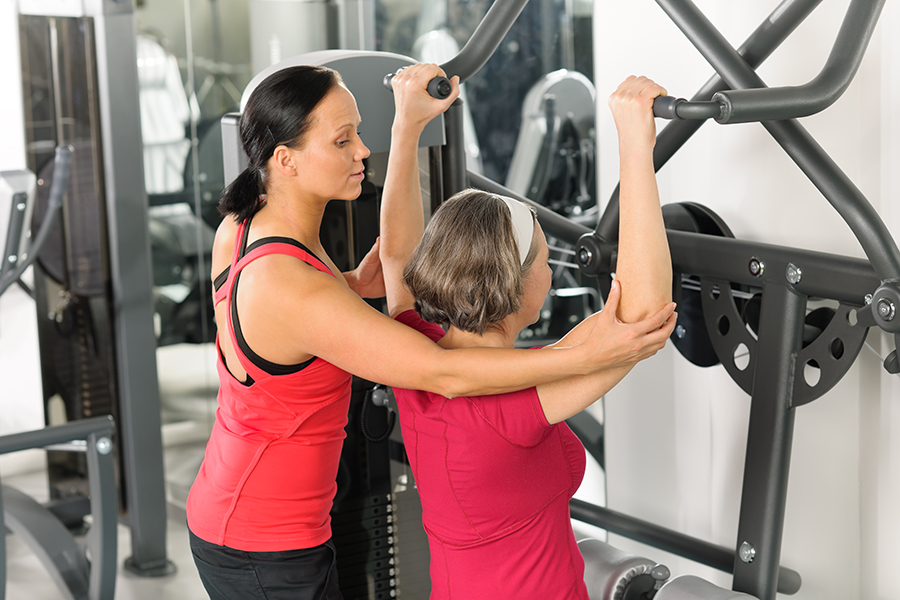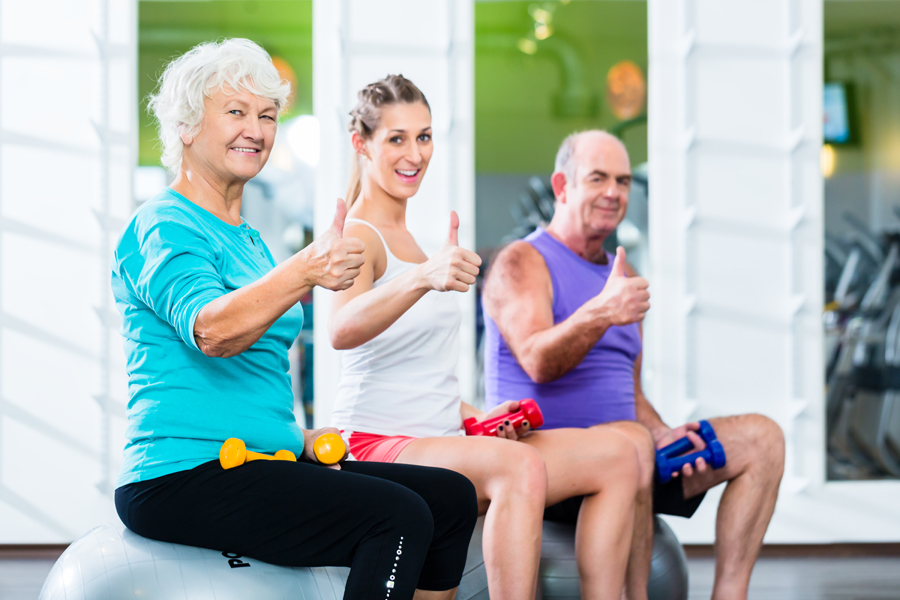Exercise Combats Frailty
 Exercise is key to maintaining muscle mass that enables performance of the activities of daily living.
Exercise is key to maintaining muscle mass that enables performance of the activities of daily living.
US Census projections suggest that the majority of baby boomers will turn 65 between 2010 and 2030, reflecting the impending need for increasing medical care within this demographic.(1-3)
“Baby boomers are now senior boomers, and just as this group has influenced everything in the past, they will impact tomorrow’s health care services as well,” says Patrick Kearns, MD, a geriatrician at El Camino Hospital in Mountain View, California.
The health and function within this group will range from those who are extremely fit and healthy to those who are physically dependent. How an individual ages is, to some extent, determined by the cards (genes) they were dealt and, to a larger extent, how they’ve played those cards. Research confirms the relationship between living a healthful, active lifestyle and both quantity and quality of life. Proactive steps taken throughout a person’s lifetime may prevent or delay the advent of frailty.(3-5)
The medical profession continues to make significant strides in treating conditions that would have caused death years ago. And while the average life expectancy has increased dramatically since the 1900s, this increase in longevity comes with the possibility of living more years with physical limitations and reduced functional ability.(3,5)
Some studies have discovered that a sizable number of adults over the age of 65 cannot lift a 10-lb bag of groceries, walk a mile, or easily get up from a chair. One study suggests a significantly increased risk of falling for individuals who cannot lift themselves out of a chair at least eight times in 30 seconds.1 But how can frailty be prevented or even reversed?
Identifying the Problem
Anyone, young or old, can experience frailty, which is the loss of some physical function and can result from various causes. Among the most common are a chronic medical condition; loss of a sensory system; changes in medical, mental/emotional, or functional fitness status; age-related muscle loss (sarcopenia); falls; or a sedentary lifestyle.(1,3,5)
Many times a combination of these factors results in a person’s inability to function independently, leading to the classification of frailty. The term “frail elder” often refers to the role age plays in the above conditions. Most of us can visually identify a physically frail person, but currently no definitive criteria exist for defining frailty. However, some professionals are attempting to develop a universal objective definition of elder frailty traits.(3,6)
Often family members, in concert with health care professionals, are the first to recognize an elder’s decline in strength and level of independence. Assessment of diminished balance and muscle strength suggest the need to initiate a comprehensive general conditioning program.(1)
Never Too Late
A recent study published in the Journal of Aging and Health showed that a group of octogenarians involved in a 16-week program of walking or resistance training could improve significantly in strength, flexibility, agility, and balance.(1,7) Of course, prevention is cheaper than treatment, so the intervention of a well-rounded fitness program should begin long before frailty concerns emerge. Some older adults admit that if they had known they’d live so long, they would have taken better care of themselves when they were younger.
Sarcopenia plays a major role in what many believe advances functional loss and contributes to becoming frail. Studies have shown that without the intervention of progressive resistance training, lean muscle tissue loss can begin as early as the age of 30.(1,3,5) These small changes go unnoticed or are even accepted as part of normal aging until a person finds difficulty in completing simple tasks. While the outward circumference of a limb may remain the same, the interior integrity of the muscle mass is decreasing. We can visualize the muscle loss as analogous to a lean steak’s transformation to one with marbled fat. So it is with humans: A muscle biopsy shows intermuscular fat within the muscle.
Why is less muscle detrimental? One reason is that muscle tissue is the furnace that revs the metabolism, thus assisting an individual to better control body weight, which in many cases decreases the risk of type 2 diabetes, hypertension, and other metabolic diseases. An increase of only 7.7% in resting metabolic rate derived from strength training would result in an increase of 50,000 extra calories expended in one year, which could result in a loss of 14 lbs of fat (in a 180-lb person).(1,5,7)
Strong leg muscles lead to improved balance.1 Strong functional muscles enable a more active and independent lifestyle. Being involved in a sensible strength conditioning program can foster improved bone density. Wolf’s Law says the strength of the bones is in direct proportion to the forces applied to them. If a person sits during most of the day, then he or she will have bones made for that kind of lifestyle. “Use it or lose it” applies to muscle strength as well as bone strength.
The hallmark study done by Maria Fiatarone, MD, a researcher at Harvard Medical School, placed 100 frail nursing home residents aged 72 to 98 into several experimental groups.(1,3,5-7) Her research found that those participating in progressive resistance exercises improved their strength significantly vs. those who were given nutritional supplements. The strength-training group increased their overall strength by 113%; gait velocity improved significantly as well stair-climbing ability over the nonexercising groups.
The take-home message was that resistance training is superior to nutritional supplementation and is far more cost-effective.
Exercise Benefits
A review of the literature appears to prove that proper physical activity has broad and positive influences over many of the characteristics associated with normal aging. It could be said that everything that physically declines with age can be positively influenced with proper exercise.(4,8,9)
We’re all familiar with normal aging, but healthful aging often is determined by the activity or lack of activity that precedes old age. An inexpensive strategy to improve the prospects of living long and well includes a regular dose of sensible physical activity. Some commonly acknowledged benefits of a well-rounded exercise program include improved self-efficacy, metabolism, sleep patterns, cardiovascular capacity, balance, muscular strength, endurance, and movement along with reduced fatigue, depression, anxiety, and arthritic and low back pain.(1,8,9)
 Designing a Fitness Program
Designing a Fitness Program
While it’s never too late to feel great, it’s best to start early. While this article attempts to show ways to intervene with a patient experiencing some level of frailty, the best solution is to encourage patients to engage in activities that help prevent it. It’s better to do a little bit of anything than a lot of nothing. Remind patients to start slow and progress cautiously. All of the exercises suggested below can be done simply with a chair. It’s even possible to perform some of the exercises in bed.(4,8,9)
Providing motivation to embark on an exercise regimen and stick with it presents a challenge, though. Suggesting participation in activities patients don’t want to do requires patience and skill. Focus on ways to make the activities appealing while preventing injury. Matching the exercise routine to a person’s personality and physical abilities often is more of an art than a science. A good coach/teacher can motivate a patient to do something he or she doesn’t want to do—and thank the coach for it later.(4,8,9)
It’s wise for health care professionals to provide patients with guidelines of indications and contraindications related to exercise. If possible, try to match patients with suitable options within the community that match their physical abilities, personalities, and social and economic issues. Some long term care facilities offer in-house and/or programs available to local older adults.(4,6,7)
An exercise program for patients at risk of becoming frail should aim to improve functional activities of daily living. An assessment by an occupational therapist, physical therapist, or nurse should provide some direction on the major areas to be addressed. While the aim of the intervention is to improve function, make sure the person leading the session keeps some fun in functional. This may require some socializing and interacting with patients. If patients are unmotivated to perform activities or exercise, even the best program will have low compliance rates and not produce the desired outcomes. All programs should follow some type of evidence-based guidelines.(8,9)
Improving muscular strength and endurance helps enhance patients’ functional muscular endurance and strength to perform daily activities without becoming fatigued. The basic concept of progressive resistance training, commonly called strength training, weight training, or weight lifting, is to begin with a resistance that can be comfortably performed six to eight times and then continue increasing the number of times (reps) until he or she can perform the movement easily between 10 and 15 times.(6)
Once that level is attained, patients can add small amounts of resistance to again challenge the muscles. As an individual advances, another set (a grouping of reps) can be added. The number of reps and sets varies depending on the objective. Matching activities to the functional tasks a person needs to perform can involve lifting a milk jug, opening jars, getting up from the toilet, or walking outside to get the mail, for example. The goal should be to build up a reserve of strength so patients can engage in any necessary activities.(4)
Strength training can include the use of resistance bands that come in varying levels of resistance. Light water bottles, hand weights, or attachable wrist/ankle weights work well. For patients who are particularly weak, simply using the weight of their limbs is a fine starting point.(4)
Cardiovascular Fitness
Aerobic simply means with oxygen. Most exercise physiologists use the example of anything you could do while holding your breath as anaerobic while the opposite characterizes aerobic exercise. Running a 100-yard dash could be called anaerobic and walking a mile aerobic. The goal of aerobic exercise is to improve the ability to move freely without becoming winded or to execute activities that facilitate locomotion, whether it’s propelling a wheelchair farther or safely walking unassisted to the dining room. This addresses breathing function as well as aerobic exercise to assist in reducing cardiovascular diseases and burning calories. Seated aerobics, peddling a stationary bike, and even walking exercise can be suitable options.
Balance and posture exercises should aim to improve the muscles that influence posture, such as the core muscles and muscles that retract the scapula as well as muscles that promote proper neck alignment. There is evidence that improved posture translates into standing erect and improved balance.
Balance activities should include both static and dynamic movements. Physical therapists can offer recommendations on exercises to enhance balance. Experts suggest patients can begin balance work in a chair, similar to activities for spinal cord-injured and post-stroke patients, as a safe exercise method.
Comprehensive Program Design
Attempting to include all of the aspects listed above would be ideal; no one element supersedes another. However, it’s often advisable to establish a baseline of patient stamina. A comprehensive exercise class can easily include each element. An example of such a class could include five to 10 minutes of warm-up moves, five to 10 minutes of upper and lower body strength training, and five to 15 minutes of light aerobic exercise followed by some light flexibility moves. All of these can be done safely if the activities match a patient’s ability. Individualization is the key even for a group exercise class.(4)
Ideally, providers can perform individual patient assessment. Utilizing a group assessment method such as the Senior Fitness Test also can provide information on fitness levels and achievable goals.
The bottom line is that exercises and activities should be adapted to a patient’s abilities and should never exacerbate an existing condition, as patient safety is more important than any exercise. If an instructor cannot appropriately adapt the movements, then he or she is not qualified to be teaching this segment of the population.
Basic Activities
A sample exercise program to prevent and improve the status of frailty should include the following:
• Range of motion/flexibility: Motion is lotion to stiff joints. A warm-up that addresses the major joints and helps prepare the body for physical activity should last between five and 15 minutes. Include gentle range-of-motion/flexibility activities that foster functional movements, such as putting on socks and shoes or getting dressed. In the early stages, this may be the limit of a patient’s capability, so stopping here is fine.
• Muscular strength and endurance: The focus is to improve functional muscular endurance and strength to enable a patient to perform daily activities without becoming fatigued. The activities should be matched to the tasks an individual needs to perform, such as lifting, dressing, and walking.
 Plan of Action
Plan of Action
There are not enough physical and occupational therapists nor insurance dollars available to provide all the functional fitness needs of this burgeoning group of older adults. We need to have a stable of well-trained fitness professionals prepared to serve the fitness requirements of today’s elders. The medical community needs to have confidence that when they refer someone to a fitness class, the instructor will do no harm. The fitness trainers of the future should understand the diversity within this group and understand how to assess and train older adults with varying degrees of ability and fitness. It’s essential to adapt fitness methods to a patient’s abilities and conditions and focus goals on improving functional wellness.
Ideally, this article will serve as a wake-up call, not only to the fitness industry but also to health care professionals to work toward establishing national standards for trainers who work with older adults. A great opportunity will be lost if there are not enough trained fitness professionals available to serve this burgeoning demographic.
The field of gerontology promotes aging in place as a viable option. If early and comprehensive frailty prevention programs can be conducted in senior centers, hospital settings, or assisted-living communities, it could possibly delay the onset of frailty along with the associated costs.
In Conclusion
The evidence is convincing that elders’ chronic illness is a powerful driver of medical costs. Research shows that a proactive lifestyle can lessen the challenges often seen in old age. Think of prevention as wholesale and treatment as retail in helping patients understand physical maintenance of their bodies. The goal is to inspire patients to be internally motivated to take positive steps toward becoming the best they can be, no matter what their age or disability.
Originally published in Today’s Geriatric Medicine. Reprinted with permission from Karl Knopf.
Karl Knopf, Ed.D, was the Director of The Fitness Therapy Program at Foothill College for almost 40 years. He has worked in almost every aspect of the industry from personal trainer and therapist to consultant to major Universities such as Stanford, Univ. of North Carolina, and the Univ. of California well as the State of California and numerous professional organizations. Dr. Knopf was the President and Founder of Fitness Educators Of Older Adults for 15 years. Currently, he is the director of ISSA’s Fitness Therapy and Senior Fitness Programs and writer. Dr. Knopf has authored numerous articles, and written more than 17 books including topics on Water Exercise, Weights for 50 Plus to Fitness Therapy.
References
1. Rose DJ. Fallproof! A Comprehensive Balance and Mobility Training Program. 1st ed. Champaign, IL: Human Kinetics; 2003.
2. Durstine JL, Moore G, Painter P, Roberts S. ACSM’s Exercise Management for Persons With Chronic Diseases and Disabilities. 3rd ed. Champaign, IL: Human Kinetics; 2009.
3. National Institute on Aging. Exercise & Physical Activity. Bethesda, MD: National Institutes of Health; 2009. NIH Publication No. 09-4258.
4. Knopf K. Total Sports Conditioning for Athletes 50+: Workouts for Staying at the Top of Your Game. Berkeley, CA: Ulysses Press; 2008.
5. National Institute on Aging. In Search of the Secrets of Aging. 2nd ed. Bethesda, MD: National Institutes of Health; 1996. NIH Publication No. 93-2756.
6. Brody LT, Hall CM. Therapeutic Exercise: Moving Toward Function. 3rd ed. Baltimore, MD: Lippincott Williams & Wilkins; 2010:1-49.
7. Ehrman JK, Gordon PM, Visich PS, Keteyian SJ. Clinical Exercise Physiology. 2nd ed. Champaign, IL: Human Kinetics; 2009:135-146.
8. Knopf K. Creating wellness. Paper presented at: Wellness Conference at the Palo Alto Medical Foundation Annual Meeting; October 2012; Palo Alto, CA.
9. Knopf K. Grow well, not old. Paper presented at: El Camino Hospital Aging In-Service; May 2013; Mountain View, CA.
